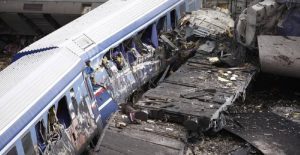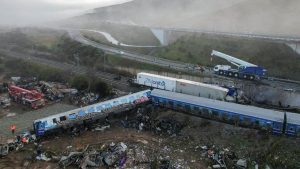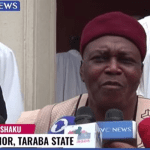Greek Prime Minister Kyriakos Mitsotakis has asked the families of the 57 people killed in a train crash this week for forgiveness.
In a Facebook message, Mr Mitsotakis said that “in the Greece of 2023, two trains heading in different directions cannot run on the same line and no-one notice”.
Protests have continued for days.
Clashes with police were reported on Sunday as thousands joined a demonstration in the capital Athens.
Police estimated 12,000 people attended the protest.

Some demonstrators set fire to rubbish bins and threw petrol bombs. Police responded firing tear gas and stun grenades, clearing the central Syntagma Square of the protesters within a few minutes.
The protesters also reportedly released hundreds of black balloons into the sky in memory of the dead, with some holding signs reading “Down with killer governments”.

On the night of 28 February, a passenger train and a freight train that were travelling in opposite directions ended up on the same track.
The first four carriages of the passenger train were derailed, and the first two caught fire and were almost completely destroyed.
The train crash has been widely attributed to human error.
Earlier this week, a 59-year-old station master in Larissa was charged with manslaughter by negligence and is due to appear in court. His lawyer Stefanos Pantzartzidis said the station master had admitted to having a share of responsibility in the accident.
But many in Greece see the crash as an accident that had been waiting to happen, and the railway workers’ union blamed successive governments’ “disrespect” towards Greek railways for leading to this “tragic result”.
Greek Prime Minister Kyriakos Mitsotakis has asked the families of the 57 people killed in a train crash this week for forgiveness.
In a Facebook message, Mr Mitsotakis said that “in the Greece of 2023, two trains heading in different directions cannot run on the same line and no-one notice”.
Protests have continued for days.
Clashes with police were reported on Sunday as thousands joined a demonstration in the capital Athens.
Police estimated 12,000 people attended the protest.

Some demonstrators set fire to rubbish bins and threw petrol bombs. Police responded firing tear gas and stun grenades, clearing the central Syntagma Square of the protesters within a few minutes.
The protesters also reportedly released hundreds of black balloons into the sky in memory of the dead, with some holding signs reading “Down with killer governments”.

On the night of 28 February, a passenger train and a freight train that were travelling in opposite directions ended up on the same track.
The first four carriages of the passenger train were derailed, and the first two caught fire and were almost completely destroyed.
The train crash has been widely attributed to human error.
Earlier this week, a 59-year-old station master in Larissa was charged with manslaughter by negligence and is due to appear in court. His lawyer Stefanos Pantzartzidis said the station master had admitted to having a share of responsibility in the accident.
But many in Greece see the crash as an accident that had been waiting to happen, and the railway workers’ union blamed successive governments’ “disrespect” towards Greek railways for leading to this “tragic result”.
Greek Prime Minister Kyriakos Mitsotakis has asked the families of the 57 people killed in a train crash this week for forgiveness.
In a Facebook message, Mr Mitsotakis said that “in the Greece of 2023, two trains heading in different directions cannot run on the same line and no-one notice”.
Protests have continued for days.
Clashes with police were reported on Sunday as thousands joined a demonstration in the capital Athens.
Police estimated 12,000 people attended the protest.

Some demonstrators set fire to rubbish bins and threw petrol bombs. Police responded firing tear gas and stun grenades, clearing the central Syntagma Square of the protesters within a few minutes.
The protesters also reportedly released hundreds of black balloons into the sky in memory of the dead, with some holding signs reading “Down with killer governments”.

On the night of 28 February, a passenger train and a freight train that were travelling in opposite directions ended up on the same track.
The first four carriages of the passenger train were derailed, and the first two caught fire and were almost completely destroyed.
The train crash has been widely attributed to human error.
Earlier this week, a 59-year-old station master in Larissa was charged with manslaughter by negligence and is due to appear in court. His lawyer Stefanos Pantzartzidis said the station master had admitted to having a share of responsibility in the accident.
But many in Greece see the crash as an accident that had been waiting to happen, and the railway workers’ union blamed successive governments’ “disrespect” towards Greek railways for leading to this “tragic result”.
Greek Prime Minister Kyriakos Mitsotakis has asked the families of the 57 people killed in a train crash this week for forgiveness.
In a Facebook message, Mr Mitsotakis said that “in the Greece of 2023, two trains heading in different directions cannot run on the same line and no-one notice”.
Protests have continued for days.
Clashes with police were reported on Sunday as thousands joined a demonstration in the capital Athens.
Police estimated 12,000 people attended the protest.

Some demonstrators set fire to rubbish bins and threw petrol bombs. Police responded firing tear gas and stun grenades, clearing the central Syntagma Square of the protesters within a few minutes.
The protesters also reportedly released hundreds of black balloons into the sky in memory of the dead, with some holding signs reading “Down with killer governments”.

On the night of 28 February, a passenger train and a freight train that were travelling in opposite directions ended up on the same track.
The first four carriages of the passenger train were derailed, and the first two caught fire and were almost completely destroyed.
The train crash has been widely attributed to human error.
Earlier this week, a 59-year-old station master in Larissa was charged with manslaughter by negligence and is due to appear in court. His lawyer Stefanos Pantzartzidis said the station master had admitted to having a share of responsibility in the accident.
But many in Greece see the crash as an accident that had been waiting to happen, and the railway workers’ union blamed successive governments’ “disrespect” towards Greek railways for leading to this “tragic result”.
Greek Prime Minister Kyriakos Mitsotakis has asked the families of the 57 people killed in a train crash this week for forgiveness.
In a Facebook message, Mr Mitsotakis said that “in the Greece of 2023, two trains heading in different directions cannot run on the same line and no-one notice”.
Protests have continued for days.
Clashes with police were reported on Sunday as thousands joined a demonstration in the capital Athens.
Police estimated 12,000 people attended the protest.

Some demonstrators set fire to rubbish bins and threw petrol bombs. Police responded firing tear gas and stun grenades, clearing the central Syntagma Square of the protesters within a few minutes.
The protesters also reportedly released hundreds of black balloons into the sky in memory of the dead, with some holding signs reading “Down with killer governments”.

On the night of 28 February, a passenger train and a freight train that were travelling in opposite directions ended up on the same track.
The first four carriages of the passenger train were derailed, and the first two caught fire and were almost completely destroyed.
The train crash has been widely attributed to human error.
Earlier this week, a 59-year-old station master in Larissa was charged with manslaughter by negligence and is due to appear in court. His lawyer Stefanos Pantzartzidis said the station master had admitted to having a share of responsibility in the accident.
But many in Greece see the crash as an accident that had been waiting to happen, and the railway workers’ union blamed successive governments’ “disrespect” towards Greek railways for leading to this “tragic result”.
Greek Prime Minister Kyriakos Mitsotakis has asked the families of the 57 people killed in a train crash this week for forgiveness.
In a Facebook message, Mr Mitsotakis said that “in the Greece of 2023, two trains heading in different directions cannot run on the same line and no-one notice”.
Protests have continued for days.
Clashes with police were reported on Sunday as thousands joined a demonstration in the capital Athens.
Police estimated 12,000 people attended the protest.

Some demonstrators set fire to rubbish bins and threw petrol bombs. Police responded firing tear gas and stun grenades, clearing the central Syntagma Square of the protesters within a few minutes.
The protesters also reportedly released hundreds of black balloons into the sky in memory of the dead, with some holding signs reading “Down with killer governments”.

On the night of 28 February, a passenger train and a freight train that were travelling in opposite directions ended up on the same track.
The first four carriages of the passenger train were derailed, and the first two caught fire and were almost completely destroyed.
The train crash has been widely attributed to human error.
Earlier this week, a 59-year-old station master in Larissa was charged with manslaughter by negligence and is due to appear in court. His lawyer Stefanos Pantzartzidis said the station master had admitted to having a share of responsibility in the accident.
But many in Greece see the crash as an accident that had been waiting to happen, and the railway workers’ union blamed successive governments’ “disrespect” towards Greek railways for leading to this “tragic result”.
Greek Prime Minister Kyriakos Mitsotakis has asked the families of the 57 people killed in a train crash this week for forgiveness.
In a Facebook message, Mr Mitsotakis said that “in the Greece of 2023, two trains heading in different directions cannot run on the same line and no-one notice”.
Protests have continued for days.
Clashes with police were reported on Sunday as thousands joined a demonstration in the capital Athens.
Police estimated 12,000 people attended the protest.

Some demonstrators set fire to rubbish bins and threw petrol bombs. Police responded firing tear gas and stun grenades, clearing the central Syntagma Square of the protesters within a few minutes.
The protesters also reportedly released hundreds of black balloons into the sky in memory of the dead, with some holding signs reading “Down with killer governments”.

On the night of 28 February, a passenger train and a freight train that were travelling in opposite directions ended up on the same track.
The first four carriages of the passenger train were derailed, and the first two caught fire and were almost completely destroyed.
The train crash has been widely attributed to human error.
Earlier this week, a 59-year-old station master in Larissa was charged with manslaughter by negligence and is due to appear in court. His lawyer Stefanos Pantzartzidis said the station master had admitted to having a share of responsibility in the accident.
But many in Greece see the crash as an accident that had been waiting to happen, and the railway workers’ union blamed successive governments’ “disrespect” towards Greek railways for leading to this “tragic result”.
Greek Prime Minister Kyriakos Mitsotakis has asked the families of the 57 people killed in a train crash this week for forgiveness.
In a Facebook message, Mr Mitsotakis said that “in the Greece of 2023, two trains heading in different directions cannot run on the same line and no-one notice”.
Protests have continued for days.
Clashes with police were reported on Sunday as thousands joined a demonstration in the capital Athens.
Police estimated 12,000 people attended the protest.

Some demonstrators set fire to rubbish bins and threw petrol bombs. Police responded firing tear gas and stun grenades, clearing the central Syntagma Square of the protesters within a few minutes.
The protesters also reportedly released hundreds of black balloons into the sky in memory of the dead, with some holding signs reading “Down with killer governments”.

On the night of 28 February, a passenger train and a freight train that were travelling in opposite directions ended up on the same track.
The first four carriages of the passenger train were derailed, and the first two caught fire and were almost completely destroyed.
The train crash has been widely attributed to human error.
Earlier this week, a 59-year-old station master in Larissa was charged with manslaughter by negligence and is due to appear in court. His lawyer Stefanos Pantzartzidis said the station master had admitted to having a share of responsibility in the accident.
But many in Greece see the crash as an accident that had been waiting to happen, and the railway workers’ union blamed successive governments’ “disrespect” towards Greek railways for leading to this “tragic result”.














